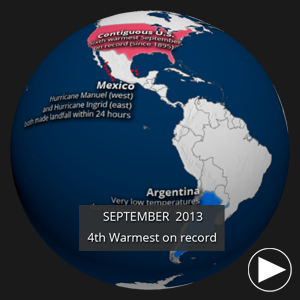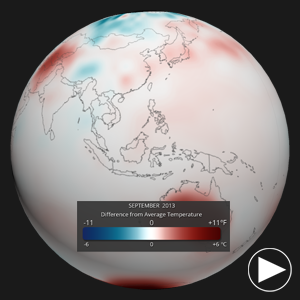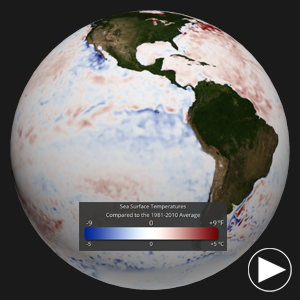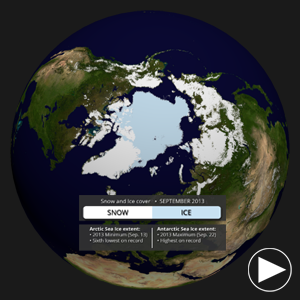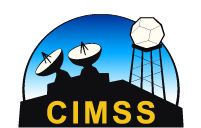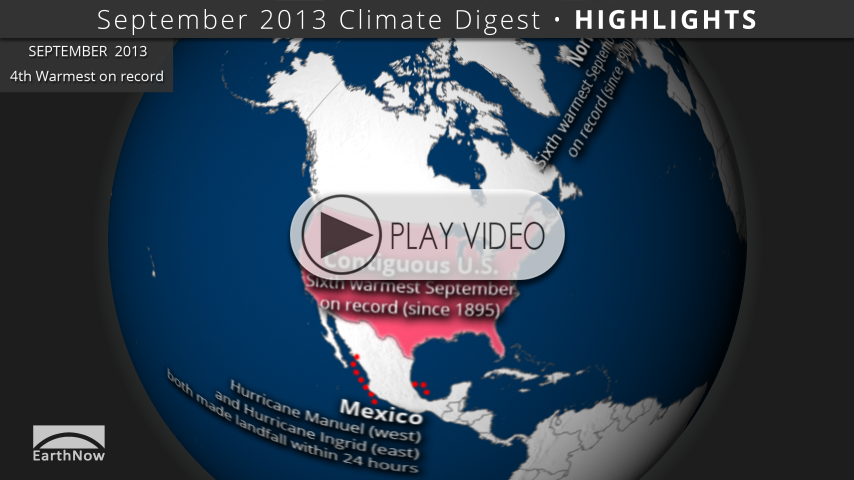 SOS Playlists
SOS Playlists
 SOS Playlist
SOS Playlist
 SOS AutoRun/Audio Playlist
SOS AutoRun/Audio Playlist
Overview
Each month, we will provide information regarding the previous month’s climate. Overall, preliminary data analysis suggests that September 2013 was tied with September 2003 as the 4th warmest on record (since 1880). Major stories include Typhoon Usagi, a record-breaking warm month for Australia, and the continued absence of El Niño or La Niña.
Highlights Dataset
Dataset: 20131025 EarthNow: September 2013 Highlights
Dataset: 20131025 EarthNow: AUDIO September 2013 Highlights
 Full Map Image
Full Map Image
- This dataset shows some of the major September weather and climate highlights from the National Climatic Data Center’s (NCDC) monthly global climate analysis, and serves as an overview of what can be discussed in the datasets that follow. Highlights are noted below with more information.
- Argentina: Very low temperatures for their Spring season. Some areas recorded their latest snowfall on record.
- Contiguous U.S.: Sixth warmest September on record (since 1895).
- Mexico: For the first time since 1958, two hurricanes (Manuel and Ingrid) made landfall on both of Mexico’s coasts with 24 hours of each other. At least 80 lives were lost from the two storms.
- Typhoon Usagi: September 16-24, Max. winds: 260 km/hr; Strongest typhoon this year.
- Australia: Warmest September on record. The mean temperature anomaly (or difference) was +2.27˚C, the nation’s largest positive monthly mean temperature anomaly on record.
- Norway: Sixth warmest September on record (since 1900).
Global Temperature Anomalies Dataset
Dataset: 20131025 EarthNow: September 2013 Temperature Anomaly
Dataset: 20131025 EarthNow: AUDIO September 2013 Temperature Anomaly
 Full Map Image
Full Map Image
- Using the real-time Monthly Temperature Anomalies dataset is a great way to convey where some of the warmer and cooler than average areas were in September, including those mentioned above in the highlights.
- The combined global land and ocean average surface temperature for September was tied with 2003, as the 4th warmest on record (since 1880).
Sea Surface Temperature Anomalies Dataset
Dataset: 20131025 EarthNow: September 2013 SST Anomaly
Dataset: 20131025 EarthNow: AUDIO September 2013 SST Anomaly
- The real-time sea surface temperature anomaly dataset is a great way to visualize the El Niño – Southern Oscillation (ENSO) cycle in the eastern tropical Pacific ocean. For September 2013, these waters were only slightly below average, indicating an ENSO Neutral period. The Climate Prediction Center anticipates a continued neutral period into the northern hemisphere Spring.
- The ENSO neutral period has lasted 17 months, making it the longest neutral period since 1992-1994.
- Remember that the blues indicate cooler than average temperatures and reds indicate warmer than average temperatures (white: average).
Snow and Ice Cover Dataset
Dataset: 20131025 EarthNow: September 2013 Snow and Ice Cover
Dataset: 20131025 EarthNow: AUDIO September 2013 Snow and Ice Cover
- Aside from helping to illustrate seasonal changes, the real-time Snow and Ice Cover dataset is a great way to convey sea ice change through time, including discussing how the current sea ice extent compares to other noteworthy years.
- The Arctic sea ice extent reached its 2013 minimum on September 13th. It was the sixth lowest sea ice extent since satellite records began in 1979.
- In Antarctica, the sea ice extent reached its 2013 maximum on September 22nd. It was the largest sea ice extent on record.
Where do I find the datasets?
-
First, check your SOS system to make sure it’s not already in the EarthNow category.
-
If not, you can download the datasets and playlist files from this FTP Site.
-
Then download and use playlist files at the top of the page (or create your own) and make sure they are in /home/sos/sosrc or /home/sosdemo/sosrc.
-
More detailed information here
Helpful Resources for More Information
-
http://go.wisc.edu/3nd6pg National Climatic Data Center (NCDC)
-
http://go.wisc.edu/9y2618 About ENSO (El Niño/La Niña)
-
http://go.wisc.edu/1nx2n3 NCDC’s Global Climate Report

